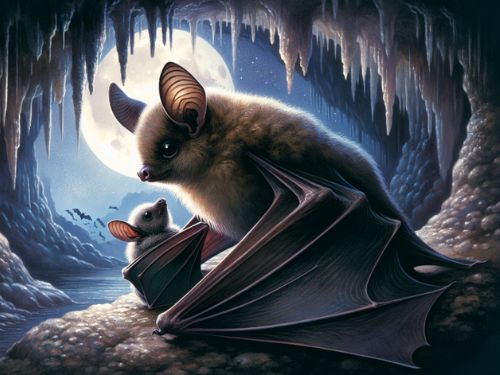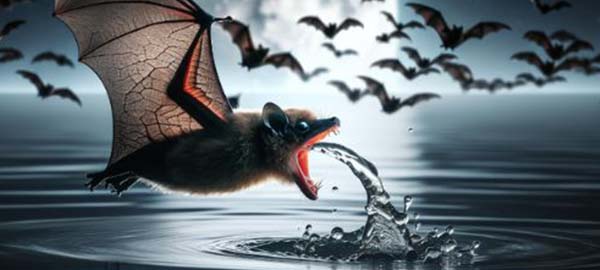Do Bats Lay Eggs?
Bats, the only mammals capable of sustained flight, have long captivated human curiosity with their nocturnal habits and diverse adaptations. One aspect of bat biology that often sparks questions is their reproductive strategy, leading to the common question…Do Bats Lay Eggs?
No. Bats Do Not Lay Eggs.
Bats are viviparous mammals, meaning they give birth to live young. Every species of bats has adapted for live birth rather than laying eggs.

The Bat Reproductive Process
We’ll now explore further into the fascinating breeding cycle of these nocturnal creatures. From polygynous mating habits to the upsidedown birth process. the world of bat reproduction is as diverse as it is captivating. Bat Reproduction involves a series of Four Stares:
Mating and Courtship
As dusk transitions into night, the mating season for bats commences. Bats do not mate for life and follow a polygynous mating system. This means a single male may mate with numerous females, and females may mate with multiple males and store sperm for extended periods, allowing them to postpone fertilization.
While the specific mating rituals have slight variations between species, mating strategies typically involve vocalizations, wing displays, and neck biting. As highly social creatures, bats use these rituals to establish pair bonds and communicate reproductive readiness.
Like all mammals, female bats possess reproductive systems adapted for live birth rather than laying eggs. After successful courtship, copulation occurs, and sperm is transferred from the male to the female’s reproductive tract.

Gestation Periods
After mating, female bats undergo a gestation period during which the fertilized eggs develop within their bodies. This gestation period varies from a few weeks to several months, and during this time the pregnant female bat nurtures the growing fetus within her body.
The length of the gestation period can vary among bat species and is influenced by environmental factors such as weather conditions and food availability. Many species time their pregnancies to coincide with the seasons when food availability is at its peak, ensuring an ample food supply for the mother bat and her offspring.

Birthing Process
The birth process for baby bats is a spectacle to behold. Bats do not lay eggs and give birth while hanging upside down. The mother bat forms a makeshift cradle with her wings during delivery, catching her newborn pup safely. This immediate contact allows the mother to guide the pup to her nipple, immediately initiating feeding. Baby bats, or pups, may weigh up to a quarter of the mother’s body weight at birth, a remarkable feat considering the small size of most bat species

Number of Pups Per Birth
The majority of bat species typically give birth to just a single pup. This ensures that the mother bat can give her full attention to raising and caring for her offspring. However, contrary to the previous belief that only single births occurred, some species have been known to give birth to twins, triplets, or even more.
The hoary bat species is known to give birth to as many as four pups at a time, while the Eastern red bat (Lasiurus borealis) can produce up to 5 pups per litter. This variation in the number of pups per birth underlines the diversity inherent in bat reproduction.

Bat Maternity Colonies
As illustrated above, bat reproduction showcases a series of fascinating processes. Yet, the journey doesn’t end at birth. For many bat species, the post-birth phase involves a unique social structure called a maternity colony. These colonies are formed by pregnant female bats who seek a safe and nurturing environment for their pups and range from small groups to massive gatherings with millions of bats.
Colony Formation
The reproductive needs of female bats drive the formation of maternity colonies. They seek out warm, safe locations that provide optimal conditions for nurturing their pups. These colonies tend to form in early summer and play a crucial role in bat reproduction.
Many female bats return to the same roosting site annually to form maternity colonies. This underscores the importance of protecting these habitats from disturbances. Interestingly, in some colonies, cooperative rearing occurs where females may take care of each other’s offspring, contributing to the survival and wellbeing of all pups in the colony.

Pup Development
Much like human infants, newborn baby bats necessitate comprehensive care. They are born blind and with large hind limbs that allow them to cling to their mothers during flight, a critical survival skill. As young bats, they are left by their mothers in a nursery crèche to hunt, recognizing their individual calls and sometimes using smell to locate them upon return in a colony with thousands of bats.
Developmental Milestones:
- Baby bats gain the ability to see within a few weeks after birth.
- Around six weeks of age, they begin to learn flying and hunting skills.
- They start preparing to survive without their mother’s milk, which sustains them early in life.

Colony Dispersal
As seasons change, maternity bat colonies gradually disperse. Bat pups typically remain with the maternity colony for about five weeks before they mature and the colony disperses. Female bats shift their focus from raising their young to preparing for winter, building fat reserves, and seeking hibernation sites. After dispersal, bats often relocate to mating roosts, marking a transition in their annual cycle towards the next mating season.

Advantages of Live Birth vs Laying Eggs
The difference between egg-laying and live birth in mammals is often influenced by their ecological niche. Bats have evolved to embrace live birth as the dominant reproductive strategy. The advantages of giving live birth are multifaceted and contribute to the resilience and adaptability of bat populations across diverse ecosystems.
Better Offspring Survival:
Live birth gives bats a crucial advantage regarding offspring survival. By giving birth to live, more developed young, bats increase the chances of their offspring thriving in the complex environments they inhabit. Newborn bats are typically more advanced in physical development and have a higher likelihood of surviving the challenges of their surroundings compared to less-developed offspring from eggs
Tailored Parental Care:
Live birth allows for extended parental care, a hallmark of bat reproductive strategies. Mothers invest time and energy in nursing their pups with nutrient-rich milk, ensuring proper growth and development. This prolonged care period facilitates the transmission of essential skills and behaviors, enhancing the survival instincts of the young bats. Tailored parental care is crucial for species inhabiting challenging environments or facing variable food availability.
Controlled Environmental Conditions:
Internal fertilization and live birth allow bats to control the environmental conditions in which their developing offspring grow. Unlike eggs exposed to external factors such as temperature fluctuations and predation risks, live birth allows for a more controlled and protected environment. This is especially advantageous for bats, given their nocturnal, flying lifestyle and the need for precise timing of reproductive events.
Synchronization with Ecological Niches:
As mentioned previously, bats can predictively time the births of their offspring to coincide with periods of peak food availability. This synchronization ensures that nursing mothers and their young have access to abundant food resources, contributing to the population’s overall health and reproductive success
Evolutionary Adaptations for Flight:
The unique demands of flight, a defining feature of bat biology, are intricately linked to their reproductive strategy. Live birth allows for the development of more aerodynamically capable offspring. Unlike birds, which lay eggs adapted to withstand the challenges of flight, live birth in bats produces young that are better suited to the dynamic and demanding nature of aerial mobility.
Frequently Asked Questions
Where Do Bats Lay Their Babies?
Bats lay their babies in maternity colonies or roosts, where pregnant females gather in warm, safe places to have their babies typically during early summer. Some groups of bats return to the same roost site every year.
How Long Are Bats Pregnant For?
Bats have varying pregnancy lengths depending on their species, ranging from three to seven months. Generally, insectivorous bats have shorter pregnancies lasting around three months, while frugivorous species have pregnancies lasting around five months. Vampire bats, on the other hand, have one of the longest pregnancies, with the young taking seven months to develop inside their mothers.
Do Bats Produce Milk?
Yes, bats produce milk to nurse their offspring, similar to other mammals. This enables them to care for their young until they are able to forage and fly on their own.
Do Bats Make Nests?
No, bats do not build nests. Instead, pregnant females of some species gather in nursery colonies to have their pups, usually from midApril through July, and their young start to fly within 3 to 6 weeks.
RELATED POSTS
Why Do Bats Fly in Circles?
Why Do Bats Fly in Circles? This distinct flying pattern is more than an aerial quirk; it's essential for their survival. Bats use circular flight patterns as a part of their sophisticated echolocation(read more)
Do Bats Drink Water?
Do Bats Drink Water? While we often associate bats with their affinity for insects, fruit, or even blood... a question lingers in the realm of curiosity: Do Bats Drink Water? Yes. Bats drink water and they require substantial amounts for survival, sometimes up to 50% of their body weight daily.
Does Home Insurance Cover Bat Removal?
Facing a bat infestation, homeowners need to know: does home insurance cover bat removal? This article directly answers that question, detailing what aspects of bat removal, if any, are covered by your home insurance policy and what costs you may need to handle yourself.




